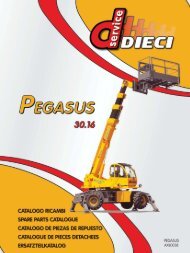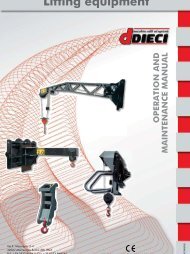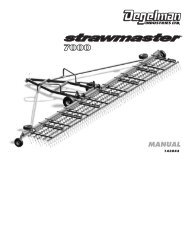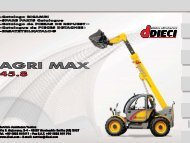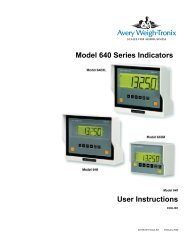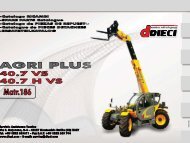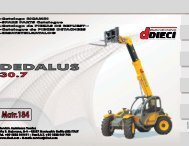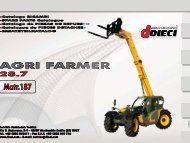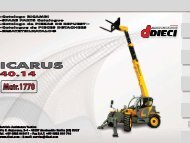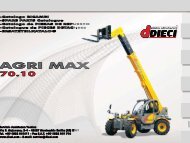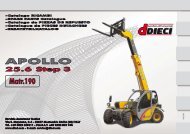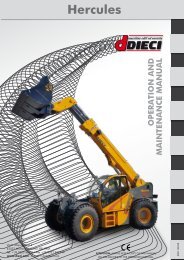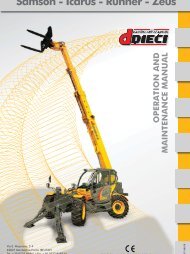BRIDGEVIEW MANUFACTURING INC - Degelman
BRIDGEVIEW MANUFACTURING INC - Degelman
BRIDGEVIEW MANUFACTURING INC - Degelman
Create successful ePaper yourself
Turn your PDF publications into a flip-book with our unique Google optimized e-Paper software.
NOTES<br />
BALE KING<br />
Vortex 3000<br />
Bale Processor<br />
<strong>BRIDGEVIEW</strong> <strong>MANUFACTURING</strong> <strong>INC</strong>.<br />
BOX 4, HWY 22<br />
GERALD, SASK. S0A 1B0<br />
CANADA<br />
Ph: 306-745-2711<br />
Fax: 306-745-3364<br />
Email: bmi@sasktel.net<br />
www.bridgeviewmanufacturing.com<br />
SERIAL # BK3338 & UP<br />
TABLE OF CONTENTS<br />
Your Authorized Dealer<br />
1??
Introduction 2<br />
Warranty Information 3<br />
Safety Precaution 4<br />
PTO Safety Labels 5-6<br />
PTO Use and Maintenance 7-8<br />
PTO Assembly and Disassembly 9<br />
Constant Velocity PTO Joint Shielding 9<br />
Machine & PTO Lubrication 10<br />
Tire Inflation and Ply Rating. 11<br />
PTO Holder and PTO Holder 12<br />
Shear bolt Clutch PTO Shaft 13<br />
Twine Guards 13<br />
Implement Tongue 14<br />
Hydraulic Hookup 14<br />
Wheel Bearings and Twine Cutter 15<br />
Loading Bales 16<br />
Hoop Grating Adjustment 17<br />
Deflectors 18<br />
Rotor Operation 19<br />
Removal of Twine 20<br />
Flail and Bushing Replacement 21<br />
Bale Tine Installation 22<br />
Cylinder Removal 23<br />
Trouble Shooting Guide 24<br />
Features and Specifications 25<br />
Fine Chop Kit Option 26<br />
The 3000 series Bale King processors have an optional fine chop knife<br />
kit available to go into the lower tub area. This option is available if<br />
you require a shorter cut on the material which you are processing<br />
such as slough hay and silage bales.<br />
It is recommended that the knives be lowered when bedding straw as it<br />
will affect your spread pattern. Adjust the machine<br />
as needed.<br />
1<br />
FINE CHOP KIT OPTION<br />
26<br />
FEATURES & SPECIFICATIONS<br />
2??
25<br />
Heavy Duty Reinforced Frame and Axle Assembly<br />
Main Frame 4”x 6”<br />
Frame Width 44.5”<br />
Heavy Duty Square Jack<br />
Mounted Inside Frame<br />
Large Bale Chamber 80”<br />
Spring Lock Lever on Grate and Deflector Adjusters<br />
Discharge Opening 10 ½”x 75”<br />
Bottom Deflector 8”x 80”<br />
Heavy Duty Bale Fork Frame 3”x 6”<br />
Bale Fork Width (on centers) 49”<br />
Small Bale Tines Optional<br />
Dual Hydraulic Lift Cylinders 2 ½”x 20”<br />
Tread Width (on centers) 72”<br />
Tire Size<br />
Standard<br />
11L x 15-8ply<br />
Optional<br />
31-13.5x15-8ply<br />
Overall Weight<br />
3900 lbs.<br />
Overall Height 114”<br />
Overall Length..w/o tines 160”<br />
Adjustable Hitch<br />
Rotor Extended Tip Diameter 26 ½”<br />
Flail Tip Speed at 1000 RPM<br />
7000 FPM<br />
Oil Impregnated Bushing in Flails<br />
Number of Flails 30<br />
Flail Size 3/4 x 1 ½ x 8 5/8”<br />
3” Stub Shaft Rotor 1 15/16” Bearings<br />
Disc Type Twine Guard<br />
PTO Shaft<br />
CV Bondioli<br />
PTO Holder<br />
Removable 1x 1 Tubing<br />
Minimum Horse Power Requirements 75 HP<br />
Shear Bolt Bondioli 10mmx 60mm GR 8.8<br />
INTRODUCTION<br />
Thank you for purchasing your new Bale King Bale<br />
processor.<br />
With the proper operation and service as outlined in this<br />
manual, the Bale King will provide you with years of<br />
trouble free operation.<br />
The Serial Number is located on upper left hand front<br />
corner of the tub.<br />
WARRANTY INFORMATION<br />
2<br />
3??
Bridgeview Manufacturing Inc.warrants the BALE KING<br />
VORTEX 3000 to its original owner for a period of two years<br />
from the date of purchase according to the following provisions:<br />
Normal Farm Use:<br />
First year warranty covers parts and labour<br />
EXCEPTION: Flails are considered a wearing part and covered for<br />
breakage for 60 days from purchase date<br />
Second year warranty covers parts only.<br />
Commercial, Government, or Rental Use:<br />
One year warranty covers parts and labour Exception: Flails are<br />
considered a wearing part and are covered against breakage<br />
for 60 days from date of purchase.<br />
• Warranty covers defects in material and workmanship.<br />
• Warranty does not cover damage to the machine and its<br />
components if the operator does not follow the operating<br />
instructions in the operator’s manual.<br />
• Warranty does not cover normal wear and tear.<br />
• Warranty will be VOID and Bridgeview Manufacturing Inc.<br />
is not liable in any way if the Bale King Vortex 3000 is used<br />
for any purpose other than it’s intended use.<br />
• Tire Warranty is covered by the Tire Manufacturer.<br />
All warranty service must be handled through an authorized Bale<br />
King dealer. Any repairs after the warranty period are the owner’s<br />
responsibility. Any Overtime requested by the owner to have the<br />
machine repaired during the warranty period will be the owner’s<br />
responsibility. Warranty is at the dealership and no travel time will be<br />
reimbursed. Freight costs associated with warranty repairs are not<br />
reimbursable. Warranty does not cover downtime. Warranty will be<br />
VOID if any component is altered or modified in any way, unless<br />
written permission is given by Bridgeview Manufacturing.<br />
Bridgeview Manufacturing Inc. reserves the right to make changes or<br />
improvements at any time without notice or obligation.<br />
3<br />
TROUBLE SHOOTING GUIDE<br />
24<br />
PROBLEM POSSIBLE CAUSE REMEDY<br />
Excessive main<br />
shear bolt<br />
breakage<br />
Excessive<br />
vibration while<br />
processing<br />
bales<br />
Beaters stopping<br />
A single beater<br />
stopping<br />
Engaging PTO at high<br />
engine speed or too quickly<br />
Excessive twine wrapped on<br />
rotor causing flail movement to<br />
be restricted<br />
Broken flails causing rotor to be<br />
out of balance<br />
Overloading rotor<br />
Incorrect Shear bolt used<br />
Operating Machine at less than<br />
1000 PTO RPM<br />
Excessive twine wrapped<br />
around rotor restricting full<br />
flail movement<br />
Hoops set in a position too<br />
aggressive for the type of<br />
material being processed<br />
causing an overload<br />
Rotating bale too fast causing<br />
rotor overload<br />
Operating machine at less than<br />
1000 PTO speed<br />
Rotor bearing failure<br />
Excessive loose material in tub<br />
causing beater to jam<br />
Mechanical flow valve not<br />
functioning correctly<br />
Coupler between motor &<br />
beater broken<br />
CYLINDER MAINTENANCE<br />
Idle tractor to engage PTO then bring<br />
up to full operating speed /feather<br />
PTO lever into position.<br />
Cut twine off rotor<br />
Replace broken flails(in pairs<br />
opposite each other)<br />
Set hoops to less aggressive<br />
position<br />
Slow rotation of bale<br />
Change direction of bale<br />
rotation<br />
Use correct Shear bolt<br />
Operate machine at rated<br />
1000 PTO RPM<br />
Remove twine from rotor<br />
Replace broken or missing flails(in<br />
pairs opposite each other)<br />
Adjust hoops to a less<br />
aggressive position<br />
Slow rotation of bale<br />
Operate machine at rated<br />
1000 PTO speed<br />
Replace failed parts<br />
Reverse direction of bale<br />
rotation<br />
Turn bale more slowly<br />
Contact your dealer for repairs<br />
Replace broken parts<br />
4??
The hydraulic cylinders are easily removed for repair<br />
or maintenance simply by:<br />
1) Lowering the fork to the down position and unhooking the<br />
hydraulic lines.<br />
NOTE: Be sure there is no pressure on the lines and mark<br />
the lines as to their placement so there is no confusion<br />
when re-installing the cylinders.<br />
2) Removing the cotter pin closest to the frame of the machine<br />
and sliding the cylinder pins out.<br />
2) To re-install, reverse the removal procedure.<br />
The following safety precautions MUST be followed to ensure safe<br />
operation of the Bale King Bale Processor.<br />
1) ALWAYS turn off the tractor when leaving the operating<br />
platform.<br />
2) DO NOT stand in front of the discharge chute while the<br />
machine is running.<br />
3) DO NOT walk or move under the bale forks when they are in the<br />
upward position.<br />
4) DO NOT enter the machine while in operation.<br />
5) DO NOT clean machine while in operation.<br />
6) DO NOT stick any device into the machine to clear debris while<br />
the machine is in operation.<br />
7) ALWAYS turn off the machine when cleaning the machine.<br />
removing twines, or hooking/unhooking the machine<br />
NOTE: Always cover exposed cylinder<br />
shafts with grease to avoid rusting on<br />
shafts if unit is not used for extended<br />
periods of time.<br />
Rusted cylinder shafts are not covered<br />
by warranty.<br />
8) ALWAYS use safety chain tow ring located directly behind<br />
the hitch on the underside of the frame when towing the machine on<br />
the highway.<br />
9) DO NOT operate if any part of the pto safety shielding is<br />
missing or is nor secured.<br />
23<br />
SAFETY PRECAUTIONS<br />
PTO SAFETY LABELS<br />
4<br />
5??
The operator must obey all safety labels and must maintain the<br />
proper shielding. A high percentage of drive-line injuries occur<br />
when safety shielding is missing or not functioning properly.<br />
To install the 3 x 3 bale tine, remove the cotter key on the hinge<br />
pin at the bottom of the main fork frame. Slide the tine into the<br />
slot at the bottom of the forks, align holes and insert the hinge pin.<br />
Install the cotter key in the pin and spread the cotter key to<br />
insure the hinge does not accidentally fall out.<br />
5<br />
3 X 3 BALE TINE INSTALLATION<br />
22<br />
6??
FLAIL AND BUSHING REPLACEMENT<br />
Flail replacement is accomplished by removing the 4 3/4”x ¾”<br />
bolt holding the flail to the rotor. The flail is then lifted away<br />
from the rotor. The bushing can now be removed by using slight<br />
pressure to push it out of the flail. Inspect the bolt, bushing,<br />
and the flail for wear. If excessive, replace with new parts.<br />
Do not operate the machine without<br />
all driveline, tractor, and implement<br />
shields in place. Drive-line shields<br />
must turn freely on the driveshaft.<br />
Bridgeview Manufacturing Inc. recommends when changing<br />
flails to change in pairs (opposite each other). Processing bales<br />
with broken flails causes the rotor to be out of balance and<br />
excessive vibration may cause machine deterioration.<br />
Before operating the machine, be sure<br />
drive-lines are attached securely to the<br />
tractor and to the implement. Check the<br />
tractor yoke.<br />
WARNING:<br />
Do not walk or stand in front of the discharge chute<br />
while processing.<br />
Keep operators and bystanders away<br />
from all moving parts.<br />
Never direct discharge chute at cattle while<br />
processing.<br />
NOTE: Contact with a rotating drive-line can cause<br />
serious injury or death.<br />
21<br />
6
PTO USE AND MAINTENANCE<br />
Safety:<br />
Shut off the tractor engine and remove<br />
the key before doing any<br />
maintenance on the machine.<br />
Use genuine Bondioli & Pavesi<br />
parts<br />
when replacing any worn or<br />
damages PTO components.<br />
Length:<br />
Confirm the minimum and maximum<br />
working lengths of the drive-line. The<br />
telescoping tubes must overlap at least<br />
1/3 of their length when in use.<br />
TWINE REMOVAL<br />
Before attempting the removal of twine from the rotor, be sure that<br />
the machine is stopped and the tractor is shut off. Place the<br />
tractor in park. Twines can be removed with the use of a utility<br />
knife or other knife. An electric device is also available from<br />
suppliers that would melt the twine& allow it to be pulled off.<br />
It is NOT ALLOWED to burn the twine from the rotor as<br />
this has several adverse effects:<br />
1) It may take the temper out of the steel, rendering it weaker.<br />
2) Loose straw and hay remaining in the machine may ignite<br />
causing a fire in the processor.<br />
3) Excessive buildup of melted plastic.<br />
4) Dry out bushings causing them to wear prematurely.<br />
NOTE: Bridgeview Manufacturing Inc. VOIDS warranty<br />
if twine burning occurs.<br />
Shielding:<br />
Be sure that the<br />
shielding is not<br />
damaged and<br />
rotates freely on the<br />
drive shaft.<br />
Working Angles:<br />
Constant Velocity joints can<br />
operate up to 80 degrees for short<br />
periods of time. Do not operate<br />
for long periods on sharp angles.<br />
7<br />
20
ROTOR OPERATION<br />
To engage the rotor for processing of a bale, be sure the PTO<br />
shaft is properly connected to the tractor. Engage the PTO at idle.<br />
After the PTO is fully engaged, increase PTO speed until it has<br />
reached 1000 RPM. Running the processor at any speed less than<br />
1000 PTO RPM may result in the flails springing back against the<br />
rotor after they come in contact with the bale. This “backslap”<br />
may cause flails to fatigue and excessive vibration which may<br />
cause the bearings to fail. Bales may be dumped into the tub while<br />
the rotor is stopped or while it is running.<br />
ROTATION OF BALES<br />
The Bale King is equipped with a flow divider/combiner and<br />
two hydraulic motors for turning the bale.<br />
Once the main rotor is turning at full speed the bale can be turned<br />
in either direction to begin processing. The faster the bale is<br />
turned in either direction, the faster it will be processed. It may<br />
be necessary to change direction of the bale when loose debris<br />
builds on either side of the bale chamber. This will remove the<br />
loose debris preventing spillage from the machine. This is<br />
especially true when processing soft core bales. By reversing<br />
direction regularly, soft core bales will process more evenly.<br />
Attachment:<br />
Be sure the drive-line is properly<br />
attached and all bolts and screws<br />
are tight on the implement input<br />
shaft and on the tractor PTO shaft.<br />
Storage:<br />
When not in use, cover or protect the drive shaft from the weather.<br />
When removed from the machine store both halves<br />
together to prevent damage. check all components for proper<br />
function and lubrication before use.<br />
BEFORE ATTEMPTING ANY REPAIR PROCEDURES,<br />
ALWAYS USE APPROPRIATE EQUIPMENT SUCH AS<br />
SAFETY GLASSES, SAFETY SHOES, AND GLOVES.<br />
When the first bale has been processed, it is common practice to<br />
leave the rotor turning at full speed when loading the second bale<br />
into the bale chamber from the rear forks.<br />
If the tractor has a flow control, adjust the oil flow so that the<br />
beaters run at a low rate. Adjust the flow as needed to find<br />
the best speed to process a bale. Turning bales too fast can result<br />
in rotor overloading resulting in flail “backslap” which in turn<br />
causes flail and bushing damage.<br />
19<br />
8
PTO ASSEMBLY AND DISASSEMBLY<br />
Shield Removal<br />
To remove the shield, push down on<br />
cone and press in the three tabs<br />
to disengage the locking nylon<br />
bearing. Slide shell off tube<br />
DEFLECTORS<br />
SIDE DEFLECTOR ADJUSTMENT<br />
Your new Bale King is equipped with a hydraulic deflector and an<br />
electric diverter valve. This allows you to use only two remotes on<br />
your tractor. E rear fork, side deflector, and wing/feed are<br />
operated by the same hydraulic lever. The middle position on the<br />
switch operates the rear forks. The deflector or wing/feed operates<br />
when you move the switch to that position.<br />
The deflector position is standard on all models, while the<br />
wing/feed is used only on 4000, 4100 or 3010, 3110<br />
models.<br />
Remove the nylon bearing to remove<br />
the plastic tubes.<br />
To remove the shield over the CV<br />
joint, remove the screws which<br />
split the shield and drop the half<br />
over the shaft.<br />
Shield Assembly<br />
Be sure to lube the groove in the inner yokes where the shield<br />
bearing rides. Re-install shields in the above directions in reverse<br />
order.<br />
9<br />
The control box requires 12 volt power.<br />
The Black wire is power and White wire is<br />
ground. Note Always attach the control<br />
box to keyed power to avoid draining<br />
the tractor battery when tractor is not<br />
being used.<br />
BOTTOM DEFLECTOR<br />
Located at the bottom of the discharge opening is a deflector<br />
which can be adjusted up or down to suit your feeding and<br />
bedding needs. It adjusts with a handle and a spring loaded pin<br />
on the front of the Bale King.<br />
Bedding- To bed an open area or corral, raise the side deflector to<br />
the upper position to allow straw to blow out evenly. The bottom<br />
deflector can be adjusted part way up or down to aid in<br />
distribution.<br />
Windrowing- To window feed along the ground simply lower the<br />
side deflector to the desired height and adjust the bottom deflector<br />
to the lower position.<br />
Bunk Feeding- Adjust the side deflector to clear the bunk and<br />
raise the bottom deflector up to throw the material up against<br />
the deflector. Drive along the bunk and process.<br />
18
HOOP GRATE ADJUSTMENT<br />
MACHINE & PTO LUBRICATION<br />
There are seven adjustment settings for the hoop grate on the<br />
Bale King bale processor. These settings determine the rate of<br />
feed of the bale you are processing and the how fine the cut will<br />
be.<br />
Position #1 Highest grate setting for finest cut and slowest rate of<br />
feed. Used for tough processing feeds such as silage bales and<br />
some types of hay.<br />
Position #2 -#6 Normal operating range. Machine gets more<br />
aggressive as grate is lowered.<br />
Position #7 Lowest grate position, Most aggressive fastest rate of<br />
feed.<br />
The Bale King should be adjusted according to various bale<br />
conditions to achieve a rate of feed of approximately 1.5 to 2<br />
minutes. Light brittle material such as wheat straw may allow<br />
faster processing while tough stringy material such as slough hay,<br />
green feed, or flax will require slower processing. Hoop grate<br />
adjustment should be checked periodically.<br />
NOTE: Processing a bale more rapidly than this may cause<br />
unnecessary machine deterioration.<br />
NOTE: Upper grate position should approximately -1/4”<br />
flail protrusion. Lower grate should allow 1 ¼” flail<br />
protrusion. Contact your Bale King dealer if this can’t be<br />
achieved.<br />
The grate assembly can be removed from the machine by<br />
removing the linkage bolts and the 3/8 bolts on the opposite side.<br />
the grate will lift out the top.<br />
17<br />
Frequent lubrication is required. Grease the driveline parts<br />
as required on the chart.<br />
After Storage for long periods of time, lubricate and check the<br />
function of every driveline component before operating.<br />
Check to see that all locations are lubed as per chart. Failure to<br />
grease all the joints will void warranty.<br />
Lubricating the Bale King bale processor should be done on a<br />
regular basis.<br />
The grease zerks are located:<br />
• on each end of the main rotor bearing blocks (grease every<br />
250 bales).<br />
• on the beater bearings on the back of the tub (grease every<br />
250 bales).<br />
• on the bale fork pivot (2 grease zerks every 250 bales).<br />
• wheel hubs (seasonally), or more often if traveling long<br />
distances.<br />
10
TIRE INFLATION AND PLY RATING<br />
The proper tire inflation for Model 3000 with standard 11Lx15<br />
8 ply tires is 35 psi. Proper tire inflation will help alleviate a<br />
puncture problem when pulling and operating the machine on<br />
rough terrain.<br />
Proper inflation for the optional tire 31/13.50x15 turf tire is 35 psi.<br />
Maximum speed for agricultural tires is 25 mph or 40 kmh<br />
NOTE: Check and tighten wheel bolts regularly to ensure<br />
that bolts are tight!<br />
Warranty does not cover damaged rims and hubs due to loose wheel<br />
bolts.<br />
LOADING BALES<br />
When loading bales into your Bale King bale processor, the<br />
following procedure should be followed:<br />
a) Position the tractor and the Bale King so as to be lined up to<br />
back straight into the row of bales.<br />
b) When close to the bale, lower the forks totally (you will feel a<br />
light vibration as the forks bottom out against the frame.)<br />
c) Back completely under the first bale.<br />
d) Allow the tractor to push forward while lifting the bale,<br />
because the bale fork moves away from the machine while<br />
loading. If you are loading from the same row you can dump<br />
the bale into the machine and back straight back for the second<br />
bale. If you are going to a different stack for the second bale<br />
only raise the first bale enough to clear the ground. Move to<br />
the next row and align the machine to the bale before dumping<br />
the bale into the tub. This gives you good visibility to line up<br />
to the second bale.<br />
e) Once you have the first bale in the tub and the second bale on<br />
the forks, raise the bale fork about ¼ of the way up. You now<br />
can transport to your feeding area to begin processing. Note:<br />
Carry the bale as low as possible so that there is less stress on<br />
the cylinder shafts. Carrying the bale high may bend hydraulic<br />
cylinder shafts.<br />
Tire warranty is covered by the Tire Manufacturer.<br />
11<br />
16<br />
12??
WHEEL HUB AND TWINE GUARD<br />
To tighten the wheel bearings, lift up each wheel (one at a time)<br />
until the wheel spins freely. Remove the dust cap and the cotter<br />
pin which retains the nut. Tighten the nut until the wheel will<br />
rotate approximately two turns when given a firm spin. Align the<br />
castle nut to the closest hole and insert the cotter pin. Re-install<br />
the dust cap and lube if required.<br />
Check and remove any twine which may wrap around the<br />
spindle.<br />
PTO HOOKUP<br />
Your Bale King Processor has a PTO shaft which is splined on<br />
both ends. The machine end uses a 1 ¾ -20 spline with wedge<br />
lock bolt. Install on the machine and tighten the wedge bolt. The<br />
bolt should be torqued to 160 ft/lbs. and re-torqued after 8 hrs. of<br />
use.<br />
The tractor end comes standard with a 1 3/8-21 spline quick<br />
detach constant velocity joint. An optional 1 ¾ spline yoke is<br />
available through your Bale King dealer. DO NOT operate the<br />
machine using an adaptor from 1 3/4” to 1 3/8”. Warranty will<br />
not cover a drive shaft failure if this occurs.<br />
Always ensure that the PTO shaft is attached securely to the<br />
tractor. When the processor is not hooked to the tractor store the<br />
shaft on the PTO holder.<br />
Do Not transport the processor without securing the PTO shaft. It<br />
may bounce off the holder and be damaged.<br />
Always ensure that the drawbar is adjusted to 16” from the end<br />
of the tractor PTO shaft to the center of the hole in the drawbar.<br />
Wheel bearings should be inspected periodically for adjustment<br />
and lubricated annually.<br />
PTO HOLDER<br />
A PTO shaft holder is standard with your new Bale King,<br />
for safe storage of the shaft when processor is not in use.<br />
When unhooking the PTO shaft from the tractor, lift the free end<br />
of the PTO shaft up and place it in the holder provided. This will<br />
keep the shaft away from the hitch when hooking the tractor to<br />
the machine and keep it clear from snow and ice.<br />
15<br />
HORSEPOWER RATING<br />
The Bale King Processor is designed to use a minimum of 75 HP.<br />
The drive shaft is shear-bolt protected. The machine must be<br />
operated at 1000 PTO RPM.<br />
NOTE: Spread yokes and twisted drive shafts are signs of<br />
overload, not a manufacturer’s defect and therefore<br />
not covered by warranty.<br />
12
TWINE GUARDS<br />
The main rotor and the beaters are equipped with removable<br />
twine guards. The guards are mounted to the front and rear wall<br />
of the machine. The twine guards are bolted and need to be<br />
removed if you need to remove or tighten the bolts on the<br />
bearings or the hydraulic<br />
IMPLEMENT TONGUE<br />
SHEAR-BOLT CLUTCH PTO SHAFT<br />
All new Bale King Processors are equipped with a shear bolt<br />
clutch located at the machine end of the PTO shaft. The shearbolt<br />
is 10mm x 60mm grade 8.8. The metric shear-bolt<br />
must be used. Any other size will damage the shear assembly.<br />
If your shear-bolt is shearing excessively you may be overloading<br />
the machine. If this occurs raise the grate assembly<br />
to make the machine less aggressive. Also roll the bale more<br />
slowly. Always ensure that your machine is running at 1000<br />
PTO RPM.<br />
NOTE: Please consult your local dealer to help pinpoint any<br />
problems.<br />
13<br />
The new adjustable hitch on the Bale King features a casted<br />
single tongue with hammer strap insert. This allows the use<br />
with tractors equipped with the hammer strap or with the single<br />
drawbar. This allows the machine move independently over<br />
rough terrain without bending the draw pin.<br />
Adjust hitch height for proper PTO alignment and level the<br />
the machine front to rear.<br />
HYDRAULIC HOOKUP<br />
Standard:<br />
There are four hydraulic hoses to be connected to the tractor.<br />
The two hoses running to the back of the Bale King operate the<br />
loading forks. The fork hoses are marked with blue collars<br />
for easy identification. The hoses with the red collars are for<br />
the beaters which turn the bale. The beater hoses should be<br />
hooked to the most convenient control lever. always set your<br />
hydraulic flow at a lower rate and adjust upward to the desired<br />
speed. Excessive oil flow will damage the flow divider cartridge.<br />
Optional:<br />
Hydraulic Deflector Option requires a third set of remotes<br />
on the tractor.<br />
14



